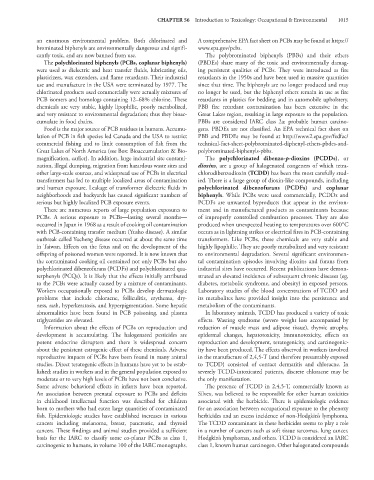Page 1029 - Basic _ Clinical Pharmacology ( PDFDrive )
P. 1029
CHAPTER 56 Introduction to Toxicology: Occupational & Environmental 1015
an enormous environmental problem. Both chlorinated and A comprehensive EPA fact sheet on PCBs may be found at https://
brominated biphenyls are environmentally dangerous and signifi- www.epa.gov/pcbs.
cantly toxic, and are now banned from use. The polybrominated biphenyls (PBBs) and their ethers
The polychlorinated biphenyls (PCBs, coplanar biphenyls) (PBDEs) share many of the toxic and environmentally damag-
were used as dielectric and heat transfer fluids, lubricating oils, ing persistent qualities of PCBs. They were introduced as fire
plasticizers, wax extenders, and flame retardants. Their industrial retardants in the 1950s and have been used in massive quantities
use and manufacture in the USA were terminated by 1977. The since that time. The biphenyls are no longer produced and may
chlorinated products used commercially were actually mixtures of no longer be used, but the biphenyl ethers remain in use as fire
PCB isomers and homologs containing 12–68% chlorine. These retardants in plastics for bedding and in automobile upholstery.
chemicals are very stable, highly lipophilic, poorly metabolized, PBB fire retardant contamination has been extensive in the
and very resistant to environmental degradation; thus they bioac- Great Lakes region, resulting in large exposure to the population.
cumulate in food chains. PBBs are considered IARC class 2a: probable human carcino-
Food is the major source of PCB residues in humans. Accumu- gens. PBDEs are not classified. An EPA technical fact sheet on
lation of PCB in fish species led Canada and the USA to restrict PBB and PBDEs may be found at http://www2.epa.gov/fedfac/
commercial fishing and to limit consumption of fish from the technical-fact-sheet-polybrominated-diphenyl-ethers-pbdes-and-
Great Lakes of North America (see Box: Bioaccumulation & Bio- polybrominated-biphenyls-pbbs.
magnification, earlier). In addition, large industrial site contami- The polychlorinated dibenzo-p-dioxins (PCDDs), or
nation, illegal dumping, migration from hazardous waste sites and dioxins, are a group of halogenated congeners of which tetra-
other large-scale sources, and widespread use of PCBs in electrical chlorodibenzodioxin (TCDD) has been the most carefully stud-
transformers has led to multiple localized areas of contamination ied. There is a large group of dioxin-like compounds, including
and human exposure. Leakage of transformer dielectric fluids in polychlorinated dibenzofurans (PCDFs) and coplanar
neighborhoods and backyards has caused significant numbers of biphenyls. While PCBs were used commercially, PCDDs and
serious but highly localized PCB exposure events. PCDFs are unwanted byproducts that appear in the environ-
There are numerous reports of large population exposures to ment and in manufactured products as contaminants because
PCBs. A serious exposure to PCBs—lasting several months— of improperly controlled combustion processes. They are also
occurred in Japan in 1968 as a result of cooking oil contamination produced when unexpected heating to temperatures over 600°C
with PCB-containing transfer medium (Yusho disease). A similar occurs as in lightning strikes or electrical fires in PCB-containing
outbreak called Yucheng disease occurred at about the same time transformers. Like PCBs, these chemicals are very stable and
in Taiwan. Effects on the fetus and on the development of the highly lipophilic. They are poorly metabolized and very resistant
offspring of poisoned women were reported. It is now known that to environmental degradation. Several significant environmen-
the contaminated cooking oil contained not only PCBs but also tal contamination episodes involving dioxins and furans from
polychlorinated dibenzofurans (PCDFs) and polychlorinated qua- industrial sites have occurred. Recent publications have demon-
terphenyls (PCQs). It is likely that the effects initially attributed strated an elevated incidence of subsequent chronic diseases (eg,
to the PCBs were actually caused by a mixture of contaminants. diabetes, metabolic syndrome, and obesity) in exposed persons.
Workers occupationally exposed to PCBs develop dermatologic Laboratory studies of the blood concentrations of TCDD and
problems that include chloracne, folliculitis, erythema, dry- its metabolites have provided insight into the persistence and
ness, rash, hyperkeratosis, and hyperpigmentation. Some hepatic metabolism of the contaminants.
abnormalities have been found in PCB poisoning, and plasma In laboratory animals, TCDD has produced a variety of toxic
triglycerides are elevated. effects. Wasting syndrome (severe weight loss accompanied by
Information about the effects of PCBs on reproduction and reduction of muscle mass and adipose tissue), thymic atrophy,
development is accumulating. The halogenated pesticides are epidermal changes, hepatotoxicity, immunotoxicity, effects on
potent endocrine disrupters and there is widespread concern reproduction and development, teratogenicity, and carcinogenic-
about the persistent estrogenic effect of these chemicals. Adverse ity have been produced. The effects observed in workers involved
reproductive impacts of PCBs have been found in many animal in the manufacture of 2,4,5-T (and therefore presumably exposed
studies. Direct teratogenic effects in humans have yet to be estab- to TCDD) consisted of contact dermatitis and chloracne. In
lished: studies in workers and in the general population exposed to severely TCDD-intoxicated patients, discrete chloracne may be
moderate or to very high levels of PCBs have not been conclusive. the only manifestation.
Some adverse behavioral effects in infants have been reported. The presence of TCDD in 2,4,5-T, commercially known as
An association between prenatal exposure to PCBs and deficits Silvex, was believed to be responsible for other human toxicities
in childhood intellectual function was described for children associated with the herbicide. There is epidemiologic evidence
born to mothers who had eaten large quantities of contaminated for an association between occupational exposure to the phenoxy
fish. Epidemiologic studies have established increases in various herbicides and an excess incidence of non-Hodgkin’s lymphoma.
cancers including melanoma, breast, pancreatic, and thyroid The TCDD contaminant in these herbicides seems to play a role
cancers. These findings and animal studies provided a sufficient in a number of cancers such as soft tissue sarcomas, lung cancer,
basis for the IARC to classify some co-planar PCBs as class 1, Hodgkin’s lymphomas, and others. TCDD is considered an IARC
carcinogenic to humans, in volume 100 of the IARC monographs. class 1, known human carcinogen. Other halogenated compounds

